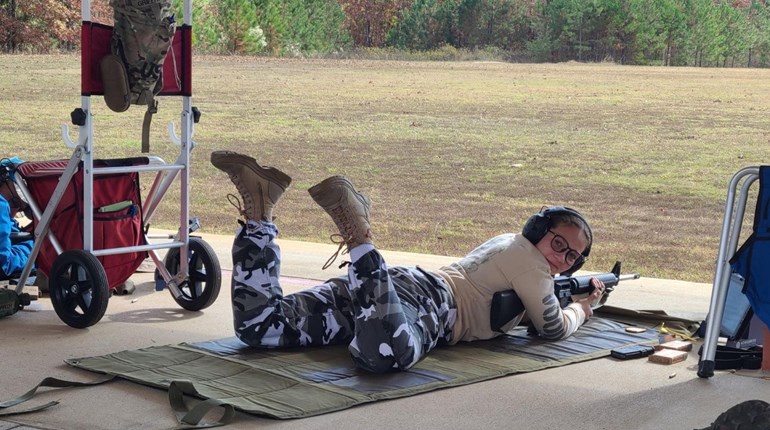
More than any other sport, shooting appeals to the independent streak in all of us. A college student particularly welcomes the challenge of competing with himself/herself. Shooters are challenged to discover their personal best and are stretched to the limits of their skills. Whether an experienced shooter or novice, any students on the campus range will find excitement building as their shots move closer to the center of their targets. The cheerleading and roaring crowds of other athletic events translate into inner cheers and broad smiles of personal satisfaction on the shooting range.
After graduation, students take with them traits that last a lifetime: self-confidence, patience, dedication, leadership, concentration and self-discipline—as well as respect for guns and range safety.
Despite these obvious attributes, there is sometimes still a question: Are the shooting sports appropriate for a campus setting? The answer is an unequivocal yes.
Every student, regardless of sex, size, or athletic ability, has the opportunity to participate at some level of collegiate shooting—for a physical education course credit, an intramural level for recreation or as part of a club. Many schools even have a varsity team.
Shooting is a multi-faceted sport. An individual competes against himself/herself in striving to reach excellence. Then, as skills grow and confidence builds, the student may develop a desire to compete with the best in college, state, national and international circuits.
The hard work and dedication required of any athlete is especially demanded of the competitive shooter who seeks to advance in the sport. With commitment, the collegiate shooter may vie for any honor, including a place on the prestigious U.S. Shooting Team. Successful shooters frequently travel to various countries and compete in international events, such as the World Championships and the Olympic Games.
A campus shooting sports program often springs from an individual's or a group's personal interests. Turning the idea into an actual shooting program, however, requires planning, coordination and work. It also takes patience, persistence and a healthy amount of preparation. A shooting program that demonstrates its compatibility with the needs and interests of the students is on its way to gaining acceptance by school administrators.
Whether a shooting program is offered as a sport or an educational course, shooting teaches safety and helps to develop sportsmanship and leadership. Safety is the hallmark of the shooting sports. It is the key to well over a century of fatality-free competition, a record unmatched by any other sport, including football, baseball and gymnastics. Safety is ingrained in the student of the shooting sports. In addition to safety, traits learned from participating in shooting sports are the key elements in any formula for competitive, academic or professional success.
Hundreds of American colleges and universities offer shooting sports programs. (Check out the NRA's list.) Some even yield academic credit in the physical education and/or ROTC departments. The shooting sports may also be part of a school's club, intramural or student recreational sports activities. Competitive shooting has been a tradition among a number of Ivy League schools and numerous schools in the East, the Midwest and the West. Varsity teams compete in a number of shooting disciplines such as rifle, pistol, air gun and shotgun. Many aspiring student-athletes have financed some or all of their education through shooting sports scholarships.
Competitive shooting opens doors to intercollegiate, national and international honors. Each year, the top collegiate shooters in rifle, pistol, air gun and shotgun are selected to be All-Americans by the National Rifle Association. Individual shooters and their teams vie for national championship titles. Collegiate competitors are even eligible for national championship matches, such as those held at Camp Atterbury.
In 1984, Pat Spurgin, a sophomore at Murray State University, won the gold medal for women's air rifle at the Olympic Games in Los Angeles. The U.S. Shooting Team fielded seven collegiate or former collegiate shooters on the Olympic Team: Deena Wigger (Murray State University), Webster Wright III (West Virginia University), Launi Meili (Eastern Washington University), Dan Durbin (University of Kentucky), Glenn Dubis (Pennsylvania State University), Rodrick Fitz-Randolph (Tennessee Tech University) and Wanda Jewell (Eastern Washington University).
In 1996, shotgunner Kim Rhode (California State Polytechnic University at Pomona) won the Olympic gold medal for double trap, and in 2000 won an Olympic bronze medal in the same event. These two wins were the first of her six consecutive Olympic medals through the 2016 Rio Games. Additionally, Rhode is a member of the NRA Board of Directors.
In 2000, University of Kentucky graduate and three-time NRA All-American Nancy Johnson won the first gold medal for the Olympics in Sydney, Australia, and for the new Millennium shooting air rifle.
At the 2004 Olympic Games, former NRA All-Americans Kim Rhode, Mike Anti (West Virginia University) and Matt Emmons (University of Alaska-Fairbanks) won a gold medal in women's double trap, silver in 3-position prone and a gold in prone, respectively.
Fast forward to the 2016 Olympics, and Ginny Thrasher, then a freshman at West Virginia University, won the first gold medal of the Games in 10-meter air rifle. Many other shooters who have made the Olympic teams attribute their shooting successes to their shooting years in college.
Organizing a collegiate shooting program is a challenge. From concept to resource evaluation, securing administrative sanction to recruiting, fund-raising, training and setting up a competition—countless organizational details are involved. An eye for detail can be helpful.
College students find the shooting range a welcome break from studies and campus routine. They often make lifelong friendships and, not the least, enjoy themselves through mastering a new sport and achieving personal goals. In other words, they find competitive shooting is fun.
See more: Choosing A Competitive Shooting Program For The College Campus



































